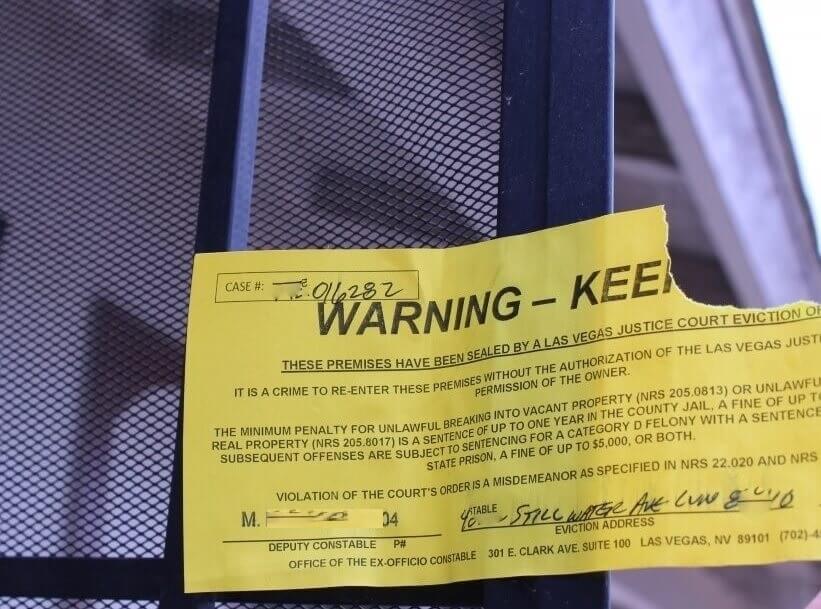(Nevada Current file photo)
As the number of evictions in Nevada remains stubbornly high following the pandemic, court diversion programs will see another infusion of funding to provide rental assistance to those at risk of losing their housing.
Assembly Bill 475, which was signed into law by Gov. Joe Lombardo last month, allocated $23 million for eviction diversion and rental assistance programs. Clark County will receive $15 million, the City of Reno will receive $5.2 million to cover the Washoe area, and the Rural Housing Authority will receive $750,000.
While the funding will aid existing programs helping to keep people housed, the demand for people needing help with unpaid rent “exceeds this allocation,” said Jamie Sorenson, the director of social services for Clark County.
Clark County, in conjunction with the Las Vegas Justice Court, launched an eviction diversion program in 2023. Reno launched a Housing Court, which includes an eviction diversion pilot program, last August to help tenants at risk of losing their housing.
“Housing Court cannot function without having rental assistance,” said Reno Judge Kendra Bertschy, adding that diversion programs “have to have that payment option” to provide assistance in order to be successful.
The court, she said, sees people who are often dealing with “economical challenges or medical emergencies or other unforeseen life circumstances that have led them towards this eviction.” Once they lose housing, they are likely to become homelessness and rely on other social services that “all costs taxpayers more money than if we had just provided them with some rental assistance and worked on keeping them stable.”
Eviction Lab, which is run out of Princeton University and collects data on eviction trends around the country, has consistently ranked the Las Vegas metropolitan area as having among the highest number of eviction filings in recent years.
Data showed the number of evictions filed in Las Vegas in April and May were higher than previous months this year, with 3,428 evictions filed in April and 3,779 filed in May.The number doesn’t indicate how many evictions were granted.
Monthly eviction filings are 45% higher than they were prior to the pandemic, according to Eviction Lab’s analysis.
Reno-specific data is not provided by the organization.
Nevada’s unique and complicated summary eviction law, which requires the tenant file with the court first after receiving a pay-or-quit notice, also makes the figures likely an undercount.
Lombardo’s vetoes once again thwart tenant-friendly housing reforms
Democratic lawmakers advanced several bills aimed at reforming the eviction system. Lombardo vetoed them all but approved legislation that allocated additional funds for eviction diversion.
Nevada’s pandemic-related eviction protections, which included legislation that temporarily paused an eviction while counties processed rental applications, ended in 2023. That same year, state lawmakers allocated $15 million to rental assistance with $12 million going to Clark County and $3 million to Reno.
The need for eviction assistance never went away.
“When I became a judge in Reno Justice Court in 2023, one of the things that we noticed was that there were a lot of filings for evictions for just non-payment of rent,” Bertschy said.
Both Washoe and Clark counties had to adapt over the last few years with the number of people following behind on rent.
The City of Reno at the time was handling applications for rental assistance for eligible tenants at risk of eviction. Bertschy said many landlords wanted to work with tenants as they worked to get assistance, but there was no guarantee how quickly the process would take.
In order to streamline the process to ensure tenants would receive assistance prior to an eviction, a housing court was created to ensure those at risk of losing housing had applications expedited.
A hearing date within housing court is scheduled 30 days after the landlord files a response with the court to allow for assistance to be processed.
During that period, tenants are given a case manager to help them determine if they are eligible for other resources like Temporary Assistance for Needy Families (TANF).
From August when the court launched through June, the has provided 105 households, or 265 people, rental assistance to stave off an eviction, according to city data.
Nearly a fourth of applicants were below 30% area median income with the remaining at or below 60% of area median income.
Data on eviction diversion in Clark County was unavailable at the time of publication.
Most of the applicants coming through the program, Sorenson said, are likely people on the verge of homelessness.
“These are individuals who have been living paycheck to paycheck,” he said. “The one time that they fall back on rent, that really spirals and leads them. If they face that eviction, it goes on their record, it makes it more difficult for them to regain other housing.”
Click this link for the original source of this article.
Author: Michael Lyle
This content is courtesy of, and owned and copyrighted by, https://www.nevadacurrent.com and its author. This content is made available by use of the public RSS feed offered by the host site and is used for educational purposes only. If you are the author or represent the host site and would like this content removed now and in the future, please contact USSANews.com using the email address in the Contact page found in the website menu.








